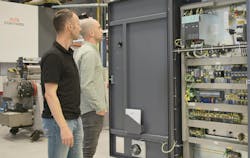The future of PLC programming: How software-defined automation is transforming industrial control
Why this article is important
- It details the shift toward virtualized PLCs, which directly impacts how controls engineers will design and implement future machinery control systems.
- It emphasizes the integration of IT tools and data-driven production, requiring controls engineers to expand their skill set beyond traditional PLC programming to include data analysis and software development methodologies.
- It highlights the importance of modular design and adaptability in automation systems, enabling controls engineers to build more flexible and easily upgradable machinery.
- It explains how SDA's sustainability benefits can influence customer demand and company priorities, requiring controls engineers to consider resource efficiency and environmental impact in their designs.
Sarah McGhee is product owner, Simatic AX, at Siemens.
What is the primary focus of software-defined automation (SDA)?
Sarah McGhee, product owner, Simatic AX, Siemens: The primary focus of software-defined automation (SDA) is to leverage proven methodologies from the software development space and apply them to the OT space. This focus can be broken down into several key pillars:
- Integration of IT-oriented tools: Utilizing IT-oriented tools brings software engineering practices into the automation programming space. While automation does not always allow for the "fail fast and break things" approach typical in software development, it should enable rapid iteration in a safe manner.
- Virtualized programmable logic controllers (PLCs) and controls: With the creation of virtualized PLCs, we are concretely decoupling control tasks from hardware devices and providing the ability to run them on high-performance industrial PCs or computers, increasing flexibility and scalability. This approach also facilitates easier integration with other applications.
- Data-driven production: Leveraging data collected from automation systems to make intelligent decisions or suggestions is critical. With the addition of artificial intelligence (AI) models, it is essential to utilize data effectively to enhance automation systems. For example, predictive-maintenance algorithms can analyze data to foresee equipment failures and optimize maintenance schedules.
In summary, SDA focuses on integrating IT tools, virtualizing control systems and utilizing data-driven approaches to create more flexible, scalable and intelligent automation solutions (Figure 1).
Key takeaways
- SDA integrates IT tools into OT, enabling faster iteration and development cycles for automation programming.
- Virtualized PLCs in SDA decouple control tasks from hardware, increasing machinery's flexibility and scalability.
- Data-driven production with AI models, a key aspect of SDA, allows for predictive maintenance and optimized machinery operation.
- Implementing SDA principles leads to more adaptable, efficient, and sustainable machinery designs, attracting a wider talent pool and reducing hardware waste.
What are the primary benefits of software-defined automation?
Sarah McGhee, product owner, Simatic AX, Siemens: Among the many benefits of SDA are its adaptability, its appeal to the workforce and its contribution to sustainability.
- Adaptability: SDA provides easy scaling up or down of control systems without the need for additional hardware or significant changes. This flexibility enables quicker responses to customer and market needs, reducing the headaches associated with hardware availability and back orders. Additionally, SDA promotes modular automation system design, where components can be operated and tested separately, enabling easier and more reliable updates by focusing on specific portions of the system.
- Workforce attractiveness: By adopting SDA principles, companies can attract a wider range of talent. SDA expands the job market for potential hires in automation positions. This cross-disciplinary approach opens opportunities for individuals with diverse skillsets to contribute to automation projects. Additionally, the efficiency gains from SDA reduce the need to fill every open position, allowing companies to maximize the productivity of their existing workforces.
- Sustainability: SDA significantly contributes to sustainability by reducing the need for hardware, which minimizes waste and lessens negative environmental impact. Additionally, data-driven production enables more efficient use of data, optimizing processes to make them more sustainable. For example, predictive-maintenance algorithms help reduce capital and human-resource consumption wrought by unnecessary prescheduled maintenance routines, in addition to environmental impact. By leveraging these capabilities, SDA creates more sustainable and environmentally friendly industrial operations.
Ultimately, SDA's flexibility, efficiency and sustainability pave the way for a more innovative and responsive automation environment.
Get your subscription to Control Design’s daily newsletter.
Tell us about your company’s state-of-the-art product that involves software-defined automation.
Sarah McGhee, product owner, Simatic AX, Siemens: At Siemens, we offer a range of tools to support users in adopting software-defined automation principles. One of our standout products is Simatic AX, an innovative engineering tool for PLCs that reconfigures the popular Visual Studio Code environment to meet the unique needs of the automation space. By leveraging a state-of-the-art IT environment, Simatic AX enables engineers to use familiar tools and methodologies in their automation programming. This approach not only reduces the learning curve, but also fosters collaboration between software and automation engineers, encouraging innovation and flexibility.
Simatic AX facilitates seamless integration with existing IT systems because it was developed with these sorts of systems in mind from the outset. It provides simple source control management, a built-in unit testing framework and smooth visualization into continuous integration pipelines, enhancing the overall efficiency and effectiveness of automation projects. These features, which are pillars of software development, have traditionally been challenging to apply in the automation space.
With Simatic AX, we’re transforming the way we approach automation engineering, expanding who can participate in it and driving faster and better innovation across the industry.
Next steps
- Explore how to implement virtualized PLCs and data-driven production strategies within machinery designs to increase flexibility and efficiency.
- Assess current skillsets and identify areas where proficiency in IT-oriented tools and software development methodologies need to be developed.
- Discuss adopting modular automation system designs to improve update processes and respond faster to customer demands.
- Research Siemens Simatic AX to understand its capabilities and how it can integrate with current PLC programming workflows.
About the Author
Mike Bacidore
Editor in Chief
Mike Bacidore is chief editor of Control Design and has been an integral part of the Endeavor Business Media editorial team since 2007. Previously, he was editorial director at Hughes Communications and a portfolio manager of the human resources and labor law areas at Wolters Kluwer. Bacidore holds a BA from the University of Illinois and an MBA from Lake Forest Graduate School of Management. He is an award-winning columnist, earning multiple regional and national awards from the American Society of Business Publication Editors. He may be reached at [email protected]




